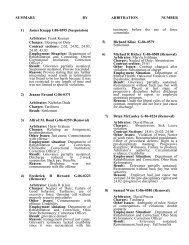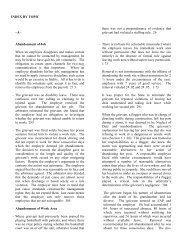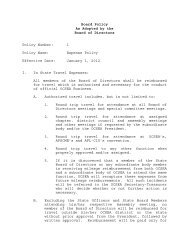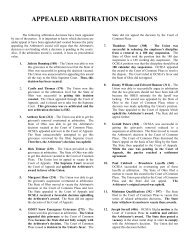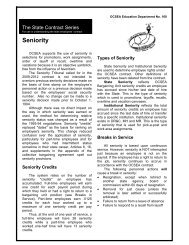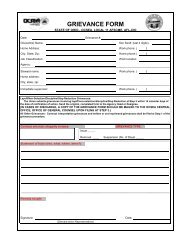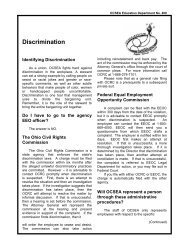by Contract Number (PDF) - OCSEA
by Contract Number (PDF) - OCSEA
by Contract Number (PDF) - OCSEA
Create successful ePaper yourself
Turn your PDF publications into a flip-book with our unique Google optimized e-Paper software.
employee cannot be on “notice” of<br />
consequences, if the consequences vary<br />
unreasonably or arbitrarily. 296<br />
The only mitigating factor in this case was the<br />
grievant’s seven years of service, but the seven<br />
years contained discipline. 296<br />
A disciplinary record weighs against mitigation<br />
even though the grievant had 17 years of service.<br />
Mitigation is further disfavored <strong>by</strong> the grievant’s<br />
repeated violent threats against the witnesses.<br />
While such behavior is not part of the removal<br />
decision it does go to the issue of mitigation.<br />
298<br />
Lack of mitigation in abuse cases. 302<br />
The most important question to be answered in<br />
any discipline case involving just cause is this:<br />
What amount of discipline is likely to correct the<br />
employee’s behavior and restore him/her to an<br />
acceptable level of performance? 302<br />
Unilateral agency rules do not define just cause.<br />
Agency rules are designed to give fair warning to<br />
employees of what types of behavior is deemed<br />
unacceptable. Agency rules may be entitled to a<br />
measure of arbitral deference, but they may<br />
never take the place of just cause. 305<br />
An agency rule may be fair on its face but unjust<br />
in its particular application, especially when the<br />
employer applies the rule without attention to<br />
mitigating factors. If the discipline falls outside<br />
the scope of just cause the arbitrator must<br />
intervene. 305<br />
The grievant was fired solely because his prison<br />
sentence forced him to violate a work rule. The<br />
grievant was incarcerated for drunk driving and<br />
did not report to work for three consecutive days<br />
which the employer deemed job abandonment.<br />
The decision to execute the penalty gave no<br />
consideration to the length and quality of the<br />
grievant’s work record or any other mitigation<br />
factors. Despite the employer’s arguments to the<br />
contrary, the action was automatic. The<br />
employer argued that the rule was reasonable on<br />
its face and the arbitrator agreed. The arbitrator<br />
also decided that the demands of just cause are<br />
almost never met when discharge is based<br />
entirely on a rule violation. Management must be<br />
cautious in inflicting the penalty. It must perform<br />
a judicious study of the employee, his/her record,<br />
and the distinctive circumstances attending the<br />
misconduct. The employer must determine<br />
whether or not elemental justice and the true<br />
need of the employer would be better served <strong>by</strong><br />
corrective rather then terminal discipline. It must<br />
bear in mind that just cause standards<br />
circumscribe management rights; they do no<br />
expand them. Just cause means that the employer<br />
can remove only those employees that are not<br />
salvageable. 305<br />
When the employer argued that the severe<br />
discipline of removal was necessary to preserve<br />
the mission of the agency, the burden of proof on<br />
this issue was on the employer. The argument<br />
that the removal was justified <strong>by</strong> the need to set<br />
an example for other employees was dismissed<br />
<strong>by</strong> the arbitrator. Employees covered <strong>by</strong> just<br />
cause may be disciplined for their own<br />
misconduct, but may not be singled out and<br />
punished with special severity as an example to<br />
Others. 305<br />
The arbitrator decided there was not just cause<br />
for termination of the grievant for abuse. The<br />
grievant did fail to report his own use of physical<br />
force and to report another employee’s abusive<br />
actions. Although these are serious violations<br />
removal would not follow the Agreement’s<br />
progressive and commensurate discipline<br />
criteria: 308 NOTE: The Union was successful<br />
in reducing the employee's discipline from a<br />
removal to a 180 day suspension. The State of<br />
Ohio took the position that the 180 day<br />
suspension is a 180 working day suspension.<br />
The <strong>OCSEA</strong> position was that the discipline<br />
should be a 180 calendar day suspension.<br />
<strong>OCSEA</strong> appealed this case to the Court of<br />
Common Pleas to resolve the dispute. The<br />
Court ruled in <strong>OCSEA</strong>'s favor and the State<br />
of Ohio did not appeal.<br />
The grievant, a Correctional Officer, was found<br />
to have intentionally exposed himself to a bus<br />
load of female inmates. This behavior occurred<br />
while the grievant was off duty. Off-duty<br />
behavior is normally not the employer’s<br />
business. To allow discipline, a clear nexus must<br />
exist between the behavior and the job. The<br />
arbitrator found that nexus in this case. The<br />
grievant charged with the safekeeping of inmates<br />
deliberately chose while in uniform, a group of<br />
female inmates as the victims of his indecent<br />
behavior. The end result would be that female<br />
inmates not knowing which male Correction<br />
Officer was involved could justifiably fear that



